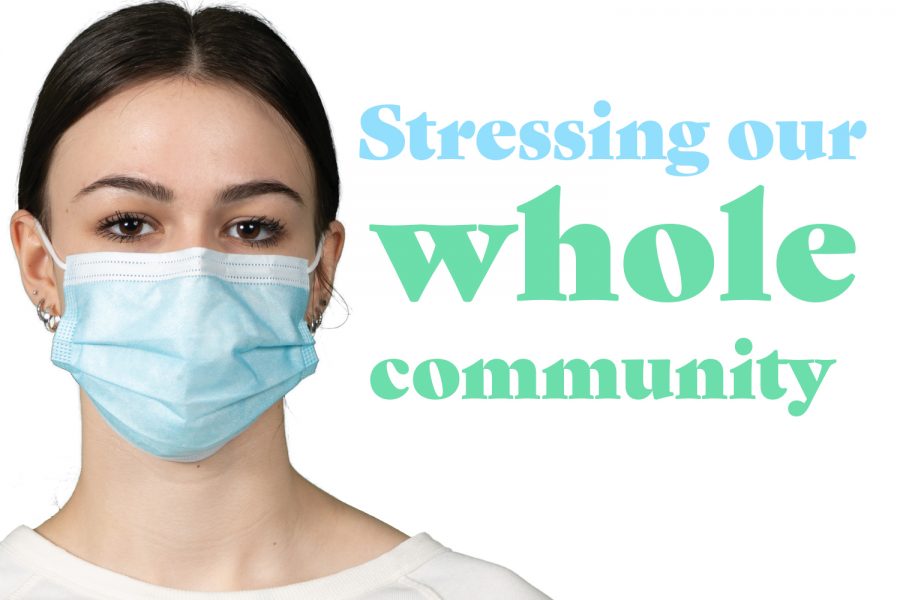COVID escalates in Texarkana area
“It is stressing our whole community,” Dr. Matt Young
March 3, 2021
March 2020. A time when the coronavirus swept the nation without warning. What was meant to be a two week break turned into a lockdown. Many thought that things would calm down after a few months. Now, almost a year later, cases continue to rise in the area, and with a spike occurring after Thanksgiving and Christmas, it doesn’t seem like those numbers are slowing down.
“People are trying to get back to their normal lives after being quarantined,” Bowie County Local Health Authority Dr. Matt Young said. “As the holidays came around, people were hoping to get back to their normal holidays or at least some [semblance of normal], but unfortunately, we’re seeing so much [of the COVID-19] spread from that.”
As of Jan. 18, there were 50 new confirmed cases in Bowie County alone, bringing the average number of reported cases to 64 per week. Currently, the total number of cases in the county is 4,876 and 139 deaths. This doesn’t take into account the other counties in our region as well as patients who are getting sent to our local hospitals. Given that Christus St. Michael’s and Wadley Regional Medical Center are the largest hospitals in the region, Texarkana has become a hub for out-of-town patients as those medical centers fill up. However, these local hospitals still only have so much space.
“All of our EMS systems, our ERs and our hospitals are at capacity,” Young said. “Every hour, probably almost every minute, we’re trying to come up with ways to handle the next patient that’s coming in. It’s a dynamic process that is in a state of constant flow to try to make sure we can handle the patients.”
Given the drastic rise in cases, the state has reinstated orders that restrict the services of restaurants and bars in the local area. Restaurants may only serve at 50% capacity and bars are completely closed.
“We want people to realize when the government [puts restrictions on] the bars and the restaurants, such as decreasing their amount of capability and capacity, [and] some of the hospitals decreasing some of their elective surgeries, we’re trying to make sure that we can care for those that are the most ill but also decrease the spread throughout the community,” Young said. “The quicker we can mask up, social distance, get our vaccination and not gather in large crowds, the quicker we can overcome this and get [businesses] back to normal.”
One beam of hope has been the arrival of the COVID-19 vaccine to medical centers around town. With only a limited number of doses, vaccinations must be deliberately given out to those most at risk. The people that are being prioritized for the vaccines are healthcare workers and residents in long-term care facilities plus people over 65 or with a chronic medical condition that puts them at increased risk for severe illness from the virus.
“Most people that are relatively young and healthy are being minimally affected by this disease process. We feel that if we can take care of the ill and those that are most susceptible to being ill first, then those that are less susceptible and less affected [by the virus will be able to get vaccinated],” Young said. “The thought process is that [the vaccine should be available for the general public] in the spring or the summer.”
Although the vaccine has shown promising results, a new strain of the virus has entered the United States, causing alarm in the health community. This new strain is believed to have originated in the United Kingdom and has inched its way to other nations with cases developing as close as Houston.
“What we know so far [is] that the treatment is not any different [than the original virus]. It is not any more deadly, and the vaccination that we’re all receiving is still protective against the new strain,” Young said. “What is concerning with the new strain is that one, it is probably a mutation of [COVID-19], and two, it is spreading much quicker than [the virus] that we’re dealing with is spread. That is concerning because it can affect [a greater number of] people in a more rapid fashion.”
Even as some battles are won against the resilient disease, the war against the coronavirus is far from over. New cases arise every day, and with that, it brings new potential for even more devastation.
“COVID-19 is, unfortunately, a very serious disease process, and we need to [treat it as such]. The more we learn [about the coronavirus], the more we realize how deadly it is, and how it is stressing our whole community,” Young said. “Just because you’re not affected, does not mean it cannot affect your loved one or potentially lead to their death.”















